|
|
|
Sort Order |
|
|
|
Items / Page
|
|
|
|
|
|
|
| Srl | Item |
| 1 |
ID:
122578


|
|
|
| 2 |
ID:
097208
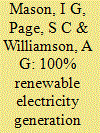

|
|
|
|
|
| Publication |
2010.
|
| Summary/Abstract |
The New Zealand electricity generation system is dominated by hydro generation at approximately 60% of installed capacity between 2005 and 2007, augmented with approximately 32% fossil-fuelled generation, plus minor contributions from geothermal, wind and biomass resources. In order to explore the potential for a 100% renewable electricity generation system with substantially increased levels of wind penetration, fossil-fuelled electricity production was removed from an historic 3-year data set, and replaced by modelled electricity production from wind, geothermal and additional peaking options. Generation mixes comprising 53-60% hydro, 22-25% wind, 12-14% geothermal, 1% biomass and 0-12% additional peaking generation were found to be feasible on an energy and power basis, whilst maintaining net hydro storage. Wind capacity credits ranged from 47% to 105% depending upon the incorporation of demand management, and the manner of operation of the hydro system. Wind spillage was minimised, however, a degree of residual spillage was considered to be an inevitable part of incorporating non-dispatchable generation into a stand-alone grid system. Load shifting was shown to have considerable advantages over installation of new peaking plant. Application of the approach applied in this research to countries with different energy resource mixes is discussed, and options for further research are outlined.
|
|
|
|
|
|
|
|
|
|
|
|
|
|
|
|
| 3 |
ID:
115109
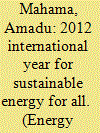

|
|
|
|
|
| Publication |
2012.
|
| Summary/Abstract |
2012 has been declared the "International Year for Sustainable Energy for All" by the UN. While Africa remains the most 'underpowered' continent, the prognosis for a brighter future is looking good, as key stakeholders (governments, private sector, civil society, and the donor community) have mobilized at an unprecedented scale to experiment with new policies, regulatory frameworks, and business models to rapidly upscale access to sustainable energy. The top-down, central grid expansion approach to increasing electricity access is very capital intensive and yet has gained considerable momentum at the expense of lower cost options that utilize decentralized off-grid solutions. A decentralized bottom-up approach could also use indigenous renewable energy sources and foster more significant linkages with livelihood opportunities in the rural un-served territories. This paper evaluates the emerging experiments through the lenses of C.K. Prahalad's "bottom of the pyramid" theory and Clayton Christensen's "disruptive technologies" perspective. Three front-runner initiatives involving new business models, innovative technologies, and institutional capacity building will be analyzed. In addition, the paper examines a regulatory policy initiative designed to stimulate clean energy investments in Ghana. Though the examples are all from Ghana, they illustrate general challenges to sub-Saharan Africa as a whole.
|
|
|
|
|
|
|
|
|
|
|
|
|
|
|
|
| 4 |
ID:
137697


|
|
|
|
|
| Summary/Abstract |
The CA-TIMES optimization model of the California Energy System (v1.5) is used to understand how California can meet the 2050 targets for greenhouse gas (GHG) emissions (80% below 1990 levels). This model represents energy supply and demand sectors in California and simulates the technology and resource requirements needed to meet projected energy service demands. The model includes assumptions on policy constraints, as well as technology and resource costs and availability. Multiple scenarios are developed to analyze the changes and investments in low-carbon electricity generation, alternative fuels and advanced vehicles in transportation, resource utilization, and efficiency improvements across many sectors. Results show that major energy transformations are needed but that achieving the 80% reduction goal for California is possible at reasonable average carbon reduction cost ($9 to $124/tonne CO2e at 4% discount rate) relative to a baseline scenario. Availability of low-carbon resources such as nuclear power, carbon capture and sequestration (CCS), biofuels, wind and solar generation, and demand reduction all serve to lower the mitigation costs, but CCS is a key technology for achieving the lowest mitigation costs.
|
|
|
|
|
|
|
|
|
|
|
|
|
|
|
|
| 5 |
ID:
116419


|
|
|
| 6 |
ID:
128416


|
|
|
|
|
| Publication |
2014.
|
| Summary/Abstract |
Air-conditioners and antibiotics are two technologies that have both been traditionally framed around individual health and comfort needs, despite aspects of their use contributing to social health problems. The imprudent use of antibiotics is threatening the capacity of the healthcare system internationally. Similarly, in Australia the increasing reliance on air-conditioning to maintain thermal comfort is contributing to rising peak demand and electricity prices, and is placing an inequitable health and financial burden on vulnerable heat-stressed households. This paper analyses policy responses to these problems through the lens of social practice theory. In the health sector, campaigns are attempting to emphasise the social health implications of antibiotic use. In considering this approach in relation to the problem of air-conditioned cooling and how to change the ways in which people keep cool during peak times, our analysis draws on interviews with 80 Australian households. We find that the problem of peak electricity demand may be reduced through attention to the social health implications of air-conditioned cooling on very hot days. We conclude that social practice theory offers a fruitful analytical route for identifying new avenues for research and informing policy responses to emerging health and environmental problems.
|
|
|
|
|
|
|
|
|
|
|
|
|
|
|
|
| 7 |
ID:
104943


|
|
|
|
|
| Publication |
2011.
|
| Summary/Abstract |
The electricity reforms were initiated in India with the objective of promoting competition in the electricity market. In order to promote competition, the Electricity Act 2003 was enacted and various policy initiatives were taken by the Government of India. Central Electricity Regulatory Commission (CERC) also facilitated competition through the regulatory framework of availability based tariff, Indian Electricity Grid Code, open access in inter-state transmission, inter-state trading and power exchanges. Despite these initiatives, electricity prices increased in the Wholesale Electricity Market in India (WEMI). This paper analyses the market structure and competitiveness in the WEMI. There are, of course, various potential reasons for the rise in the electricity price. This paper seeks to investigate, if market power was one of the reasons for increase in market prices. Concentration ratio, Herfindahl-Hirschman index, Supply Margin Assessment, and Residual Supply Index have been used to measure market power. This paper also uses the price-cost mark-up to examine, if exercise of market power led to higher margins. The analysis suggests that market power of firms may be part of the reason for the increase in electricity prices in WEMI. The study suggests various measures to increase competition in the WEMI.
|
|
|
|
|
|
|
|
|
|
|
|
|
|
|
|
| 8 |
ID:
088258


|
|
|
|
|
| Publication |
2009.
|
| Summary/Abstract |
The links between emission and energy markets are of great interest to practitioners, academics and policy makers. In this paper, it is conjectured that a positive relationship exists between emission allowance spot returns and electricity risk premia within the European Union Emissions Trading Scheme (EU ETS). We discuss how this can be justified on the basis of the substantial uncertainties in the carbon markets. We also argue that this link could be due to trading strategies followed by electricity producers who attempt to exploit their initial allocation of free allowances. Analysis of data from three major markets, the EEX, Nord Pool and Powernext, offers empirical support to our conjecture. These findings have significant policy implications since they imply that efforts should be made in order to reduce the uncertainty in the carbon markets by clearly defining the EU ETS regulative framework and design over the next years. Moreover, our results suggest that the allocation of free allowances and their unrestricted trading enable electricity producers to accomplish windfall profits in the derivatives market at the expense of other market participants.
|
|
|
|
|
|
|
|
|
|
|
|
|
|
|
|
| 9 |
ID:
105778
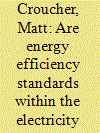

|
|
|
|
|
| Publication |
2011.
|
| Summary/Abstract |
There is a growing trend to introduce energy efficiency standards at the state level. We examine why electricity utilities may be in favor of such a standard and conclude that energy efficiency standards may be a form of regulatory capture.
|
|
|
|
|
|
|
|
|
|
|
|
|
|
|
|
| 10 |
ID:
175026


|
|
|
|
|
| Summary/Abstract |
With state-led support being only temporary, attention has turned to retail electricity markets to provide long-term support for renewable electricity. Past research has focused on consumer preferences for green electricity, i.e. the demand side. We investigated the supply side by analyzing what suppliers selling green retail electricity products in the UK, Germany, France and Italy actually provide. Through content analysis of the online data provided by these companies, we found that most products in Germany and France rely on Scandinavian hydropower. Since almost all of these plants have been operating for decades, these products today cannot be said to effectively drive new renewable capacities. Products in the UK and Italy rely on sources which already have state-led support and thus also do not drive the expansion of renewables. In fact, none of the four countries has established a policy framework that successfully fosters the development of a voluntary market for green electricity capable of driving the expansion of renewables. Alignment between sustainable energy policy objectives, consumer demand, and supply-side offerings in a voluntary market might be improved by empowering consumers through a simplified and possibly state-led labeling scheme that focuses on environmental impact and includes minimum standards for performance.
|
|
|
|
|
|
|
|
|
|
|
|
|
|
|
|
| 11 |
ID:
090079


|
|
|
|
|
| Publication |
2009.
|
| Summary/Abstract |
Electricity sector is among the key users of natural gas. The sustained electricity deficit and environment policies have added to an already rising demand for gas. This paper tries to understand gas demand in future from electricity sector. This paper models the future demand for gas in India from the electricity sector under alternative scenarios for the period 2005-2025, using bottom-up ANSWER MARKAL model. The scenarios are differentiated by alternate economic growth projections and policies related to coal reforms, infrastructure choices and local environment. The results across scenarios show that gas competes with coal as a base-load option if price difference is below US $ 4 per MBtu. At higher price difference gas penetrates only the peak power market. Gas demand is lower in the high economic growth scenario, since electricity sector is more flexible in substitution of primary energy. Gas demand reduces also in cases when coal supply curve shifts rightwards such as under coal reforms and coal-by-wire scenarios. Local environmental (SO2 emissions) control promotes end of pipe solutions flue gas de-sulfurisation (FGD) initially, though in the longer term mitigation happens by fuel substitution (coal by gas) and introduction of clean coal technologies integrated gasification combined cycle (IGCC).
|
|
|
|
|
|
|
|
|
|
|
|
|
|
|
|
| 12 |
ID:
107489
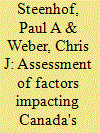

|
|
|
|
|
| Publication |
2011.
|
| Summary/Abstract |
In this article we develop and then implement a decomposition model of Canada's electricity sector in order to assess multiple factors impacting on trends in greenhouse gas emissions from the sector, with a focus on the impact of climate and energy policy on emissions for the time period spanning from 1990 to 2008. The analysis shows that during these years, the primary factors driving changes in emissions included changes in electricity demand, changes in the generation mix of electricity, and weather, but that government policy and programs had only minor impacts on emissions. Although having relatively lesser impacts compared to the aforementioned factors, the most significant policy related factors included efforts to increase renewables in the generation mix through programs such as renewable portfolio standards and incentives for wind generators.
|
|
|
|
|
|
|
|
|
|
|
|
|
|
|
|
| 13 |
ID:
099360


|
|
|
|
|
| Publication |
2010.
|
| Summary/Abstract |
This paper provides an assessment of the large-scale implementation of distributed solar photovoltaics in Wisconsin with regard to its interaction with the utility grid, economics of varying levels of high penetration, and displaced emissions. These assessment factors are quantified using simulations with measured hourly solar radiation and weather data from the National Solar Radiation Database as primary inputs. Hourly utility load data for each electric utility in Wisconsin for a complete year were used in combination with the simulated PV output to quantify the impacts of high penetration of distributed PV on the aggregate Wisconsin electric utility load.
As the penetration rate of distributed PV systems increases, both economic and environmental benefits experience diminishing returns. At penetration rates exceeding 15-20% of the aggregate utility load peak, less of the PV-energy is utilized and the contribution of the aggregate electricity generated from PV approaches a practical limit. The limit is not affected by costs, but rather by the time-distribution of available solar radiation and mismatch with the coincidence of aggregate utility electrical loads. The unsubsidized levelized cost of electricity from PV is more than four times greater than the current market price for electricity, based on time-of-use rates, in Wisconsin. At the present time, the investment in solar PV as a cost-effective means to reduce emissions from traditional electricity generation sources is not justified.
|
|
|
|
|
|
|
|
|
|
|
|
|
|
|
|
| 14 |
ID:
168688
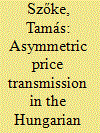

|
|
|
|
|
| Summary/Abstract |
The article compares the market power of Hungarian electricity traders during the partially liberalised transitional market model from 2004 to 2008 and the fully liberalised period lasting since 2008. In our empirical work, we use an econometric modelling technique based on asymmetric price transmission (APT) theory to measure the market power of traders in the electricity market. The aim of our work is to conduct a quantitative analysis of the Hungarian electricity trading market by applying the APT modelling technique – used widely in agro-economic analyses – to electricity markets. The intuition behind the method is the assumption that asymmetric price transmission refers to deviations from perfect competition. The research has found that different regulation regimes lead to different patterns of asymmetry in price transmission and the results underline that the market position of electricity traders have improved since the introduction of the liberalised market model. By mapping the results of the APT model to the actual policy and market changes we argue that the APT method is a useful tool for analysing the competition on electricity markets.
|
|
|
|
|
|
|
|
|
|
|
|
|
|
|
|
| 15 |
ID:
181459


|
|
|
|
|
| Summary/Abstract |
Low carbon development involves profound changes in existing countries’ governing structures. Recent studies have shown that significant benefits to low carbon development in developing countries can be achieved from energy sector transitions. This paper argues that energy transition in Botswana which involves reduction of dependence on coal-generated electricity and increase in the uptake of solar energy can only be achieved through regime-based reconfigurations driven by deliberate government action and political will. It draws on energy transition literature to examine whether existing policy instruments can drive the desired transition. Through in-depth qualitative analysis, it identifies barriers that impede transition attempts to date. As an effort to overcome regime level barriers in particular, the paper proposes several low-cost changes in the existing electricity regime to facilitate a wider energy sector transformation.
|
|
|
|
|
|
|
|
|
|
|
|
|
|
|
|
| 16 |
ID:
166929
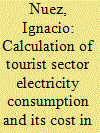

|
|
|
|
|
| Summary/Abstract |
The Canary Islands is a European archipelago whose principal economic activity is international tourism. Due to its geographic isolation, it does not have any connection with continental electricity grids. The Spanish state subsidises the extra cost of electrical energy generation in isolated systems. The purpose of this study is to quantify the proportion of the electricity bill that corresponds to tourist activity that is being subsidised. With this aim, three complementary methodologies have been developed. These tools could also be used in similar environments. The results reveal an average tourist sector consumption in the study years (2014–2017) between 12.8% and 16.5% of the total amount of electricity generated in the archipelago, with a monetary value of Spanish state subsidy estimated in €143.5 M in the year 2014. Additionally, a calculation was made of the values of CO2 emissions due to tourist electricity consumption for the years of the study period, with an estimated peak of 1.1 MtCO2 in 2017. From the point of view of energy policy, these results could be used to justify the adoption of various types of compensatory measures, including ecotaxes to be paid by the tourist visitor.
|
|
|
|
|
|
|
|
|
|
|
|
|
|
|
|
| 17 |
ID:
092813


|
|
|
|
|
| Publication |
2009.
|
| Summary/Abstract |
This study investigates the causality from environmental investment (as a long-term effort) and expenditure (as a short-term effort) to financial performance in the US electric utility industry. The industry is one of the large air polluters in the United States. This empirical study finds that the environmental expenditure under the US Clean Air Act has had a negative impact from 1989 to 2001. The negative impact has become much effective after the implementation of the Title IV Program (1995) of the US Clean Air Act. This study cannot find the influence of environmental investment on financial performance by a statistical test although it indicates a positive impact. In the United States, fossil-fueled power plants such as coal-fired ones still produce a large portion of electricity. The generation structure is inconsistent with the betterment in the US environmental protection and imposes a financial burden to electric utility firms.
|
|
|
|
|
|
|
|
|
|
|
|
|
|
|
|
| 18 |
ID:
122875


|
|
|
| 19 |
ID:
094880


|
|
|
|
|
| Publication |
2010.
|
| Summary/Abstract |
This paper investigates the impact that a federal government structure has on strategic selection of renewable energy policy instruments. The context for this study centers on wind power development in Canada. Canada is a nation that is blessed by all the attributes necessary to catalyze global leadership in installed wind power capacity. Unfortunately, the constitutional separation of powers that underpins Canada's federal system impedes the creation of a national wind power development strategy because Canada's provinces have constitutional authority over electricity governance. The insights gleaned from the case study are used to develop a conceptual framework for understanding the impact that federal structure has on policy instrument selection and efficacy under areas of federal, regional and concurrent policy jurisdiction. Finally, this framework is re-applied to identify specific approaches the Canadian federal government could take to resolve what currently amounts to be a fragmented, ineffective approach to wind power development planning.
|
|
|
|
|
|
|
|
|
|
|
|
|
|
|
|
| 20 |
ID:
088254


|
|
|
|
|
| Publication |
2009.
|
| Summary/Abstract |
This paper addresses the issue of investment in electricity generation in the context of a liberalised market. We use the main results derived from a theoretical model where firms invest strategically to simulate the Spanish electricity system with real-world data. Our results indicate that, under reasonable parameter constellations regarding the number of agents, the level of capacity resulting from private decisions falls well short of the social optimum. Last, we show that two regulatory mechanisms that have been used to generate additional incentives for private agents to install capacity (capacity payment and price-adder) are ineffective and/or prohibitively costly.
|
|
|
|
|
|
|
|
|
|
|
|
|
|
|
|
|
|
|
|
|